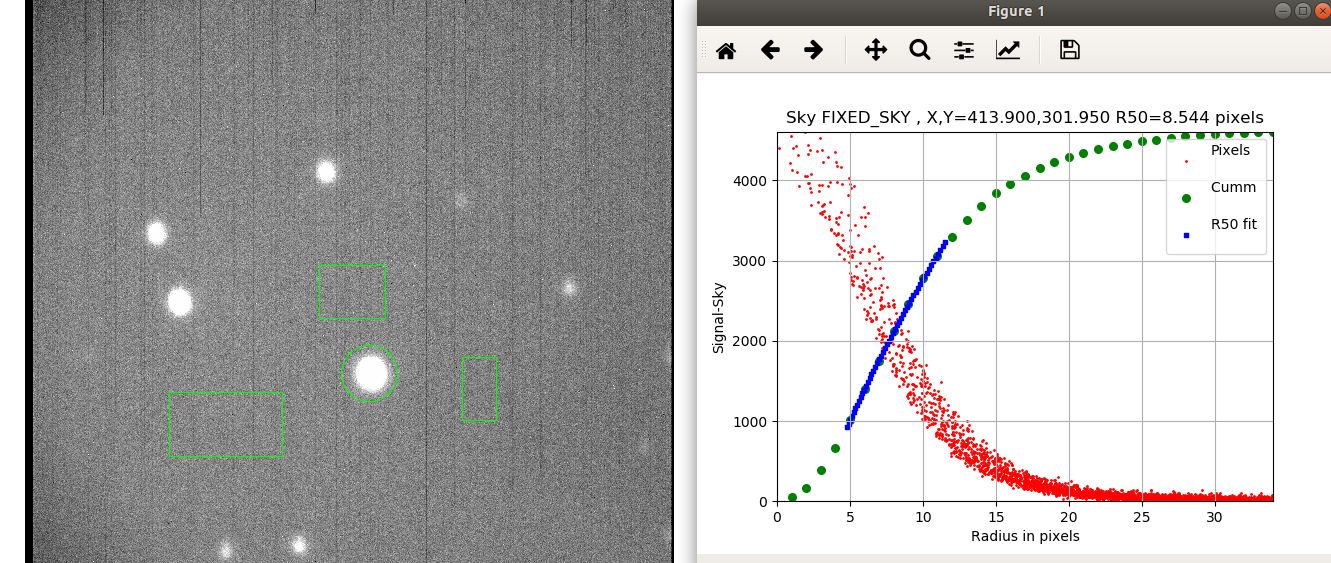A revised and experimental version of ds9_profiles.
Actually, the original ds9_profiles was experimental also. It was intended to verify and visualize
the source code need to compute a radial intensity profile. As the name implies we can use three
type of ds9 regions to define and measure an aperture that is: an ellipse, a circle, a box. The box
region can be used to measure fixed (constant) sky estimates for every aperture meausered in a run.
The boses can also be used to measure the X or Y marginal distrubutions needed to, for instance,
measure a spectral line profile. There are some fancy-pants routines for doing things like setting
an ellipse for the center or a galaxy and also one for the outer isophote of the galaxy.
% ds9_profiles_x --help
usage: ds9_profiles_x a.fits [-v] [-h] [-fp] [-s ] [-m ]
Additional options:
-v = print verbose comments and run in debug mode
-h = show a help file and then exit
-s, --sky = sky method (FIXED SKY,LOCAL_SKY)
-m, --maxk = pixel exclsuion mask (can be none)
Below I show a sample run intended to point out the most important features and
output files of ds9_profiles_x.
% ds9_profiles_x 20191018T084633.3_acm_sci.fits -s FIXED_SKY -v
Note that becasue O use "-s FIXED_SKY" I will set some sky boxed. I use the "-v" flag
becasue I want to leave the shit-ton of peripheral files made in the run so that I can
show some important ones below. Whn you use the "-v" flahg, this routine will be extremely
verbose and you will hav to respond to many questions like "Enter any key to continue:".
But, all in good fun.
The most important file from the ds9 run is "profpars.out". This will contain the infomation
needed for measuring the profile of each aperture (one aperture per line, each aperture
defined by a ds9 region):
% cat profpars.out_explain
# Output columns from profpars (using midodata.2)
Col01 = X center, pixels (from centroid)
Col02 = Y center, pixels (from centroid)
Col03 = semi-major axis length in pixels
Col04 = b/a axis ratio
Col05 = position angle (degrees) of major axis
Col06 = local background measured in local annulus
Col07 = mean bkg (signal per pixel) from BOX regions
Col08 = mean error of mean bkg (BOX regions)
Col09 = id, line number in regions file
% cat profpars.out
413.900 301.950 34.000 1.00000 0.000 482.8040 479.3014 3.0678 1
Note that column 6 has the local sky value measured in the local annulus used by mido.sh.
Column 7 is the mean sky value measurede with the 3 sky boxes I set.
After the run for our simple aperture is completer, we wee:
% ls
20191018T084633.3_acm_sci.cdfp 20191018T084633.3_acm_sci.info
20191018T084633.3_acm_sci.fits 20191018T084633.3_acm_sci.reg ap_1/
The profile infomation for our one aperture is in two table files in ./ap_1:
% ls ap_1
profile_gcurve_kfit.parlab profile_gcurve.parlab profile_pnts.limits profile_pnts.parlab
profile_gcurve_kfit.table profile_gcurve.table profile_pnts.log profile_pnts.table
profile_gcurve.log profile_pnts.header profile_pnts.out
profile_pnts: The individual (pixel) profile points
% cat profile_pnts.parlab
rad Radius in units of pixels
I-Isky Signal (above background) in ADU
i x pixel position in full image
j y pixel position in full image (pixels)
I Signal (adu)
Isky Background Signal (adu)
rad^0.25 Radius**0.25 (Radius in pixels)
log(I-Isky) log10 of Signal(adu) above background
% table_checker profile_pnts N
3622 8
gcurve_kfit: The cuumulative signal curve.
% cat profile_gcurve_kfit.parlab
rad Radius in pixel units
k Fraction of total Signal
% table_checker profile_gcurve_kfit N
50 2
The large-text blue info shows why this is a demo code! The profile
file is huge, and this is only for a star. A large galaxy in the image would
be insanely large. What we need to go along with our demo code is a routine
that runs much of the computational source code of ds9_profiles_x, but holds
this profile information in memeroy. We could parameterize of fit the profile
with something beyond a simple R50 value and we could fo it for many apertureds
on an image.
